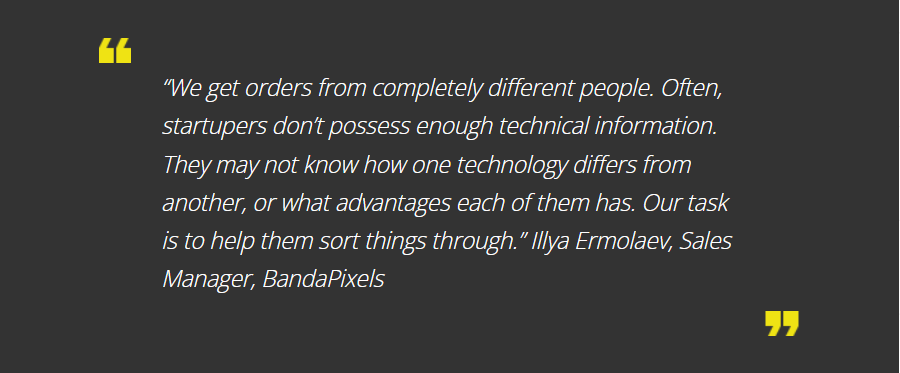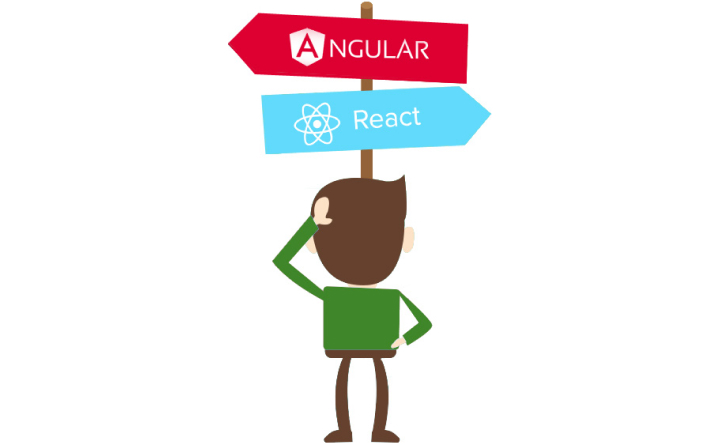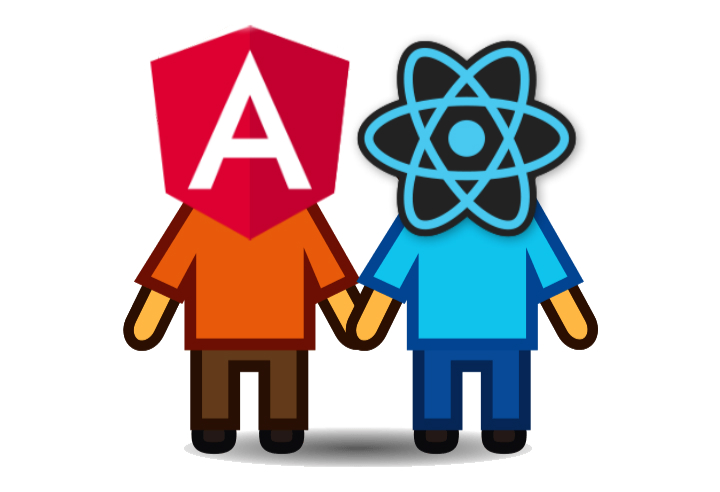The Right Choice – Right Business
In the modern world of global digitalization, a product that doesn’t exist on the Internet – doesn’t exist at all
9 June, 2023
The Right Choice – Right Business
In the modern world of global digitalization, a product that doesn’t exist on the Internet – doesn’t exist at all. Many startupers and businessmen have already done justice to the ability of different web resources to promote and advertise their product, brand or idea. However, a successful entrepreneur or an expert in his business sometimes lacks enough technical knowledge when dealing with direct implementation of his idea. Selection of a framework can become one of such tricky cases in the process of creating a website. It influences the project budget, deadlines and future support directly.
In this article, we will closely analyze Angular and React frameworks from the point of view of the experts who directly participate in the creation of the product, starting with the discussion of a technical task with a client and ending with the implementation of an ultimate product by the developer.

What are Frameworks and What do They Do Exactly?
Angular and React represent so-called frameworks with a huge number of a ready-to-use feature set. They make the developer’s life easier, but at the same time, undoubtedly exert influence on the workflow in general. The programmer’s need to write all code from scratch disappears, for he already holds the bunch of ready-made solutions in his hands. Usage of Angular and React accelerates the entire development stage and grants access to SPA technology (single page application) that helps to speed up all interactions taking place on the website.
Angular and React are widely used in website development and underly many world brands. For instance, such well-known companies as Eat24, CVS shop, one football, Google Express, NBA, Delta use Angular technology, while React underlies Facebook, Instagram, Whatsapp, Uber, Netflix.
What is in the Box?
Who better than the developer that is directly connected with Angular and React frameworks to know about all ins and outs when working with such technologies.
Angular and React simplify the website development process, since the necessary feature set lies “in the box”.

A high level of usability and a great number of ready-to-use components appear to be one of the most considerable advantages of Angular. Imagine that you have bought a phone that comes together with headphones, a charger, a case, a user manual and many other various goodies. In the same way, Angular includes all necessary components and modules, which don’t need additional setting and time required for their search and installation. And due to the fact that all necessary elements are included initially, time spent on the project configuration shortens to a great extent.
Convenient management and support of large projects with a big code base is another Angular’s strong point, by all means. Code that takes up 100 lines in React, will occupy about 20-30 lines in Angular, or it can even be represented in the form of a certain ready-to-use feature. This, in its turn, guarantees convenient project management in the long run.
Nothing is Perfect
However, there is nothing perfect in this world and no matter how impeccable may Angular seem at first glance, it is fraught with a number of disadvantages. One of the most important among them lies in resizing the ultimate file. Since the browser supports only the Javascript language, the necessity arises to transpile Angular syntax into one the browser understands, namely Javascript syntax. As a result of this process and due to a great number of instruments built in the framework, the size of the ultimate file can increase to 8-10 MB.

A Look from Inside
The relatively small file size appears to be one of the biggest advantages of React technology in comparison with Angular. For instance, when the size of the ultimate project based on Angular compounds 8-10 MB, the size of the exact same project written on React technology will be decreased to 1-2 MB. They actually connect this with the fact that React represents a bare nucleus that lacks any ready-made additional modules. Angular, on the contrary, includes multiple ready-to-use complementary components. This feature of React enables us to reduce the download speed of the project essentially.
On top of that, React technology is generally less demanding in terms of computer resources. This means that by performing particular actions inside the website, such as emersion of a pop-up window, sending a request on a server, getting a response from a server, style changing and others, React will demand less computer capacity than Angular.
In the case of the React framework, one of the biggest minuses can be considered to be a relatively big amount of time required for project configuration. When using Angular, all components are always close at hand, don’t require additional search and allow you to create a ready-to-use structure by adding only several commands. However, working with React, the developer is forced to spend more time searching for these very elements and selecting libraries. This suggests that the total amount of time for project configuration can increase.
Different Technologies, Different Us
Let’s say, you have an idea to create a certain website for your brand or product, but you can’t differentiate Angular from React. As a result, certain doubts may arise, such as “Should I really start this? And if yes, how?” Experienced specialists in the branch of sales management can help you give a clue to complicated notions at the early stage and recommend the most suitable variant depending on your preferences and goals.

The stage of identifying needs during a phone meeting helps to determine the client’s goals and objectives, understand problems and weaknesses. In the process of communicating with the client and proceeding from his desires and preferences, it becomes clear which of two technologies – Angular or React will be more suitable in this case.
Do you Know What you Want?
For example, Angular technology is more suitable for projects where deadlines and future convenient support are of the highest importance. If there is no hurry and the client is interested in the application’s fast download speed, a manager will recommend opting for React framework. Planning the creation of your product’s future website, it is important to understand to what extent you’re ready for the possible budget supplement. Due to the fact that React technology doesn’t include a ready-made feature set at the initial stage of project development, a programmer will need more time to search for necessary components, which increases the total amount of working hours and implies the increase in the project budget at the early development stages. At the same time, further project support will be a bit more expensive due to a large number of code lines, which will cost the developer more time and effort.
Discussion of a new project is not that easy and requires total engagement with the process from both sides. Often, customers who are used to working with one technology are likely to continue using it in their current project. For instance, in one of the projects our company was working on, the client was using Angular JS, a slightly out-of-date technology. The task of our manager was to help the client to become aware of that issue, specify advantages and disadvantages of the preferred technology and suggest a qualified task solution, for example, to use the newer version Angular 2+. The work of the specialist who is familiar with such an outdated technology will be rather expensive, and the cost of adjustments will, therefore, be much higher than the development of the same project based on Angular 2+ entirely from scratch.

Selecting the framework itself is extremely important for the client. Despite the fact that the team of experienced developers will be able to fulfill all customer’s desires according to the technical enquiry, framework selection will first of all influence the client, his plans and expectations from the project.
The main difference between Angular and React frameworks lies in the fact that Angular consists of a great number of ready-to-use elements. Let’s say, you need to create a new webstore. When using Angular, which works slightly slower than React, developers will have to deal with the optimization of the project feature set in order to get a qualified and fast workflow of the entire product. At the same time, the feature set is written from scratch in the majority of cases when working with React, which respectively affects the deadlines of the project implementation.
It is important for the team of specialists to understand the tasks and goals of the project as well as the desires and preferences of the client. One or another technology, which will help to solve the problems of the project but not cause harm, is picked up depending on these fundamental factors. An experienced specialist will always be able to give advice and pick up appropriate technology according to the peculiarities of the upcoming project. Nevertheless, the client has to be fully aware of his/her requirements and desires regarding the project.

Attention to Details
If operation speed is important
Being quite a lightweight technology that occupies relatively less space in comparison with Angular framework, React suits best for the projects where a fast download speed is of the highest importance. It is connected with the fact that the file based on React technology will weigh several times less in comparison with the file based on Angular technology. At the same time, Angular implies that the download speed of the project is not a top priority. But it doesn’t mean that the project based on Angular technology will take half an hour to download instead of the usual several seconds. Actually, the download speed of such an application will increase simply by a few seconds, and average users will hardly notice such an insignificant difference.
How much do your ideas weigh?
Large projects are the most suitable for Angular framework. Using this technology in big projects, we obviate the possibility of budget increase and keep download speed unchanged. At the same time, despite the relatively small weight of the file, React technology deals with large projects a bit worse. The evidence of this can be a couple of important problems that may arise as the consequence of working with big tasks, such as budget increase and a hard-going support of the project afterwards.
Support and management
Let’s say that you have to improve a rather large-scale project based on the React framework. When you engage new developers in this project, they will be forced to spend way more time studying old code and making sense out of it. Consequently, not only terms of support become worse, but the project budget increases too. In respect to Angular, it is far easier to execute further support of the project due to a smaller amount of code lines in the project. In other words, the developer won’t spend such a great amount of time studying the project based on Angular technology.
Budget
Apparently, the budget planned on initially will be successfully saved using Angular technology. It is connected with the fact that the developer already has all necessary components that don’t require additional time on searching, providing the specialist with the possibility to save precious time and release the client from the necessity to pay extra for the additionally completed work.
However, the budget increase will affect only large-scale projects. The cost of a relatively small application will be the same, regardless of which framework it is based on – Angular or React.

At first glance, it seems as if Angular and React frameworks don’t have much influence on the implementation of any type of the project – a big or a small one. It is a false opinion, however. Every minute of our life we make a certain choice. Staying on the sidelines, making no move, doing nothing at all – it’s a choice too. And often the client, deciding to create a web application for his project for the first time, doesn’t imagine to what extent his choice and his decision are actually important.
Web application development is a very laborious and painstaking process. This is the process that demands an increased focus on all details without exception. It is worth mentioning that an average user will hardly notice any difference between these two frameworks. But one should understand, the choice of this or that technology has a direct influence on the client and their product, meeting the project deadlines, fast download speed and convenient support.
Be attentive to little things – make the right choice.
Let's work together to make your project a success
Contact usLast News
Thank you!
We’ve received your contact request and will contact you soon
Something went wrong
We couldn’t receive your contact request. Please try again later.